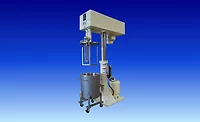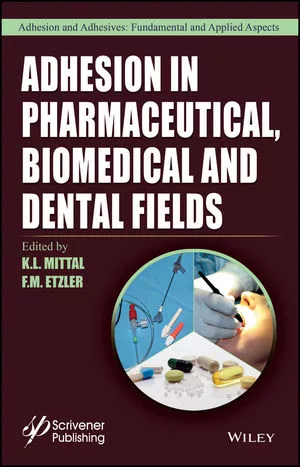Anchors Aweigh
A new structural adhesive recently withstood successful trials and may prove to offer major production benefits.

 The new Crestabond primerless methyl methacrylate (MMA) structural adhesive from Scott Bader has been successfully tested by Interboat NL in the Netherlands. The adhesive has proven to be a much faster and cleaner method of fitting the GRP engine foundation part in the company’s 5.7-m-long (18-ft) fiberglass sloop, when compared to traditional glass and resin overlaminating.
The new Crestabond primerless methyl methacrylate (MMA) structural adhesive from Scott Bader has been successfully tested by Interboat NL in the Netherlands. The adhesive has proven to be a much faster and cleaner method of fitting the GRP engine foundation part in the company’s 5.7-m-long (18-ft) fiberglass sloop, when compared to traditional glass and resin overlaminating.
A significant reduction of more than 60% in the overall assembly time was achieved. Shop floor conditions were also improved, as the new adhesive offers reduced styrene exposure. In addition, dust from grinding the hull surface, which normally takes place prior to overlaminating, is eliminated. In terms of surface preparation, Crestabond only requires a wipe-down of all the contact surfaces with a solvent in order to remove contaminants such as grease and dirt.

Preparation
The bond areas on the engine foundation base and the hull were wiped with solvent and a clean cloth.
Position
The engine foundation part was positioned to its correct place in the hull prior to the adhesive application. An outline of the exact position was then drawn with a marker. The GRP engine foundation section measured approximately 2.2 m (7 ft) long by 1 m (3 ft) wide.
Application
The engine foundation section was lifted clear, and the Crestabond M1-20 adhesive was applied to the hull surface using an air-assisted 380-ml cartridge gun, following the pre-marked bond line (approximately 6 m [19 ft] around). Crestabond M1-20 was determined to be the most suitable choice for this particular application because of its 16- to 22-minute working time and its gap fill properties of up to 25 mm (1 in.).
Placement
The final step required workers to swing the GRP engine foundation section back over the hull and carefully lower it down onto the adhesive, positioning it using the marked outline. Due to some dimensional variance at certain contact points, it was necessary to apply a bit more adhesive to fill some gaps. A small brush was then used all around the bond line to smooth out any surplus adhesive. Wooden struts were also bonded into place at this point.
The entire assembly process from start to finish took just 15 minutes, with minimal mess or waste. This was a significant time savings compared to the 40 minutes typically needed to surface grind and overlaminate the same part.
Curing
The sloop was then left to allow the bonded section to cure. Crestabond M1-20 fully cured in 70 minutes and was then ready to undergo a bond strength test.

The bond maintained its integrity. After a thorough inspection of the joint line by the Interboat team, it was confirmed that the Crestabond joint was intact all around the engine foundation section.

Kooman went on to say that he “liked the positive reaction of all the shop floor workers. They took to applying the Crestabond product with the air-assisted gun easily and were very happy not to be wearing full masks or having to use the grinding machine to prepare the hull surface. This type of bonding is definitely a good way to help create a cleaner and better working environment on the shop floor.”



Following a simple solvent wipe surface preparation, the engine section was positioned in the hull and a bond line drawn around it.
A significant reduction of more than 60% in the overall assembly time was achieved. Shop floor conditions were also improved, as the new adhesive offers reduced styrene exposure. In addition, dust from grinding the hull surface, which normally takes place prior to overlaminating, is eliminated. In terms of surface preparation, Crestabond only requires a wipe-down of all the contact surfaces with a solvent in order to remove contaminants such as grease and dirt.

With the engine part lifted clear, the Crestabond was applied with an air-assisted, 380-ml cartridge gun.
Step by Step
The bonding trial on the 5.7-m sloop was conducted last year by Patrick O’Shea, Scott Bader’s adhesives sales development manager, at the request of Wim Kooman, Interboat’s production manager. The demonstration necessitated several important steps:Preparation
The bond areas on the engine foundation base and the hull were wiped with solvent and a clean cloth.
Position
The engine foundation part was positioned to its correct place in the hull prior to the adhesive application. An outline of the exact position was then drawn with a marker. The GRP engine foundation section measured approximately 2.2 m (7 ft) long by 1 m (3 ft) wide.
Application
The engine foundation section was lifted clear, and the Crestabond M1-20 adhesive was applied to the hull surface using an air-assisted 380-ml cartridge gun, following the pre-marked bond line (approximately 6 m [19 ft] around). Crestabond M1-20 was determined to be the most suitable choice for this particular application because of its 16- to 22-minute working time and its gap fill properties of up to 25 mm (1 in.).
Placement
The final step required workers to swing the GRP engine foundation section back over the hull and carefully lower it down onto the adhesive, positioning it using the marked outline. Due to some dimensional variance at certain contact points, it was necessary to apply a bit more adhesive to fill some gaps. A small brush was then used all around the bond line to smooth out any surplus adhesive. Wooden struts were also bonded into place at this point.
The entire assembly process from start to finish took just 15 minutes, with minimal mess or waste. This was a significant time savings compared to the 40 minutes typically needed to surface grind and overlaminate the same part.
Curing
The sloop was then left to allow the bonded section to cure. Crestabond M1-20 fully cured in 70 minutes and was then ready to undergo a bond strength test.

The engine section was carefully dropped into place onto the Crestabond adhesive and accurately positioned in the hull. Any gaps were filled, and a small brush was used around the edges to smooth any excess adhesive.
Bond Strength Testing
For the bond strength test, the sloop was filled with 180 kg (396 lbs) of ballast, making its total weight 500 kg (1,100 lbs). The lifting gear was attached to fixtures that had been secured to the top of the engine foundation section. The craft was lifted clear of its cradle and left to hang so that the adhesive bond line took 100% of the strain.The bond maintained its integrity. After a thorough inspection of the joint line by the Interboat team, it was confirmed that the Crestabond joint was intact all around the engine foundation section.

Engine section and wooden struts bonded into place. Crestabond M1-20 was fully cured and ready for the bond strength lifting test within 70 minutes.
Results
After the trial, Kooman stated that he was “impressed with both the rapid bond performance and workability of this new Crestabond adhesive. For such a strong bond to be achieved in just over an hour with no preparation, other than a clean with solvent, really surprised me. When we lifted the sloop up off the cradle with the crane, I was really not expecting the bond to hold, but it did. I am now convinced. It has really opened my eyes to much bigger bonding opportunities on some of the larger cruisers we make, such as in deck-to-hull bonding, where I think we can make huge savings in production time. This will be our next bonding trial with Crestabond.”Kooman went on to say that he “liked the positive reaction of all the shop floor workers. They took to applying the Crestabond product with the air-assisted gun easily and were very happy not to be wearing full masks or having to use the grinding machine to prepare the hull surface. This type of bonding is definitely a good way to help create a cleaner and better working environment on the shop floor.”

The Crestabond bond line held the full 500 kg weight of the sloop when it was lifted clear of the cradle. A thorough inspection confirmed that the bond line maintained its integrity throughout.
Adhesive Options
In the current Crestabond range, five adhesives are designed to bond a variety of composite, metal and plastic substrates. All have a 10:1 mix ratio and offer a choice of working times from 4-100 minutes to suit most production processes. Crestabond is available in a range of pack sizes depending on user requirements, including 380-ml coaxial cartridges, 20-l pails or 200-l drums for bulk dispensing applications.About Interboat
Interboat annually produces around 220 high-quality fiberglass cruisers, tenders and sloops in a range of sizes from 5.7 to 10.5 m. The head office and main showroom is located in Loosdrecht (approximately 20 km southeast of Amsterdam), and production operations are located in Zwartsluis. As a forward-thinking company with a modern approach to manufacturing, Interboat is always looking for improvements in production. Scott Bader was introduced to Interboat by its composites distribution partner, Advanced Plastics NL, which distributes the full range of Crystic® resins, gelcoat, and adhesives in the Netherlands. For additional details, visit www.interboat.com.About Scott Bader
Established in 1921, Scott Bader is a £180 million (approximately $287 million) multinational chemical company that employs more than 500 people worldwide. It is a common trusteeship company with no external shareholders and a strong commitment to supporting its customers, workforce, and the environment. Based in the UK, the company’s purpose-built, state-of-the-art technical facilities provide R&D and complete evaluation, testing, and application support. The company has manufacturing facilities in the UK, France, Croatia, the Middle East and South Africa. For more information, call (44) 01933-663100, e-mail info@scottbader.com or visit www.scottbader.com.Links
Looking for a reprint of this article?
From high-res PDFs to custom plaques, order your copy today!






